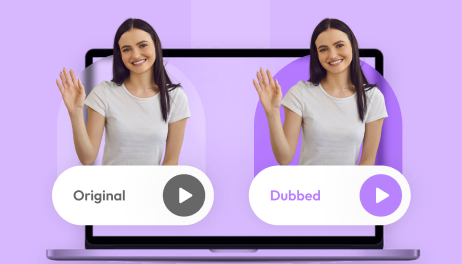Ever wondered how a Hollywood blockbuster sounds just as thrilling in your native language? That’s due to professional-grade audio dubbing!
Through audio dubbing, a movie or show can be given a fresh voice in another language, so you can enjoy the same level of action, drama, or comedy without missing a beat.
Let’s explore how dubbing transforms content and makes it universally enjoyable, no matter where you’re watching from.
Understanding Audio Dubbing
Audio Dubbing refers to translating or replacing the original language of any content with another language. It happens by translating the dialogues and re-recording new voices that can be synchronized with the original character’s movements and expressions.
Unlike subtitles, which display only translated texts while keeping the original voice, dubbing completely changes spoken dialogue. However, this strategy helps viewers enjoy the video in their native language without reading the subtitles.
The Process of Audio Dubbing
Now that you know what voice dubbing is, let’s examine its process. The dubbing process is not just about switching the language—it’s about making everything sound natural. From choosing the right voices to perfect syncing, every detail counts to get it right. So, let’s discuss this whole process.
1. Script Translation
First, it needs to translate the original script into the target language. This is not a word-for-word translation; the generated voice needs to match the tone and timing of the original scenes.
2. Voice Casting
Next, voice actors are selected. These actors need to match the characters’ personalities, emotions, and sometimes even the pitch and tone of the original voices. Casting the right voices is crucial for making the dubbed version feel authentic.
3. Recording
The voice actors then record the new dialogue in sync with the video. This step requires precision to ensure the words match the characters’ lip movements and timing. Specialized dubbing software is used to handle this syncing process.
4. Editing and Mixing
This is the post-recording process. The recorded voice is carefully edited to remove any mistakes. Now the dubbed version is mixed with the original soundtrack, such as sound effects and background music. This makes the dubbed dialogues sound natural and perfectly aligned with the original footage.
Types of Audio Dubbing
There’s more than one way to do it when we talk about voice dubbing! If you’re about matching lip movements or narrating over scenes, each type of dubbing serves a unique purpose. Let’s explore the different methods and how they work!
1. Lip-Syncing Dubbing
Lip-sync dubbing is the most common type of dubbing used in various content. In this process, the new dialogue is carefully synchronized with the character’s lip movements. The advanced voice transcription tools play a vital role in ensuring the timing is right so the dubbed audio feels natural.
2. Voice-Over Dubbing
In this type of dubbing, the original dialogue is replaced with a new voice, but it’s not always synced with the lip movements of the characters. This is often used in content that only requires voiceovers, such as documentaries or animated videos. Here, the voice narrates over the visuals rather than matching them exactly.
Hence, each type of dubbing has its own use depending on the content and audience needs.
Why is Audio Dubbing Important?
Audio dubbing is a vital art that gives new life to stories. By adding voices in different languages, it helps people from various cultures connect emotionally with the content. Let’s learn more and discuss some noticeable benefits of using voice dubbing:
1. Voice Localization
Subtitling enables content to be translated so that the audience listens to the dialogue in their preferred language. This makes the experience more interesting and easier to grasp than constantly reading subtitles.
For instance, an english movie might be dubbed into French for French-speaking audiences, allowing them to enjoy the film as if it were originally made in their language.
2. Enhanced User Experience
Moreover, the voice dubbing process also uses text-to-speech technology to ensure the dubbed voices sound natural and match the original performance. This helps maintain the emotional impact and authenticity of the content, ultimately enhancing user experience. This means a viewer watching a Japanese anime in English can still enjoy voices that fit the characters’ personalities.
3. Wider Reach
Likewise, creators and businesses benefit by reaching a wider audience and enhancing followers. In this way, people worldwide can enjoy their content through dubbing, hence overcoming language barriers. Just imagine a beautiful show like ‘Money Heist’; although the series is in Spanish, adding subtitles in multiple languages makes the series popular globally.
4. Cultural Adaptation
Dubbing is not limited to the translation of the words; it also translates the cultural gestures, making the content more relevant to the targeted audience. For instance, a sports reference in an American cartoon may be replaced by a local sport when translated for dubbing in another country so that the audience can resonate with that show.
The Role of Voice Actors in Dubbing
Voice actors are the unsung heroes of dubbing! They transform characters by adding new voices that match the original emotions and personalities. Let’s understand why their role is so vital:
1. Bringing Characters to Life
Voice actors give new voices to the original characters, aiming to match their emotions and expressions. No matter whether the character is joyful or heartbroken, the voice actors need to convey that exact feeling to match the accuracy.
2. Matching Lip Movements
Moreover, voice actors are careful about sync their lines properly with the scene’s character to make the dubbed dialogue look natural. However, this requires perfect timing to ensure that the new dialogue fits well with the on-screen action.
3. Maintain Consistency
In series or sequels, voice actors must maintain consistency in their performance. This means they need to stay the same throughout the scene, which makes the audience stay connected to the characters across episodes.
4. Adapting to Different Styles
Apart from that, voice actors must be versatile. They must have the ability to adjust their performance to match different genres, from animated comedy to tragedy or dramas. Adapting these skills, each piece of content remains true to its style and tone.
Technological Advancements in Audio Dubbing
Audio dubbing has come a long way, only because of the cutting-edge technology. What once took hours of manual recording and syncing has now become faster and more efficient with advanced tools. Let’s discuss:
- AI Voice Generators: Like other advanced technologies, AI voice generators work seamlessly to make dubbing process quicker. You can get real sounding voices in just minutes.
- Voice Cloning: With advanced voice cloning technology, now it’s possible to replicate a specific voice and use it across different languages. This technology ensures the character’s voice remains same, even in different dubs.
- Automatic Lip Syncing: Automatic Lip-Syncing New software helps match dubbed audio with the character’s lip movements, so the words and mouth movements align perfectly. This makes the dubbing process smoother, and the results look more natural, without needing as many manual fixes.
- Cloud-Based Recording: With cloud technology, dubbing can now be done from anywhere. Voice actors can record and edit their lines remotely, working together from different locations.
However, these advancements have made dubbing more accessible, accurate, and engaging for viewers across the globe.
Wavel AI: Revolutionizing the Audio Dubbing Process
Let’s be honest, audio dubbing can be a challenging task. But what if there is a tool that made it much easier? You heard it right! Give a try to Wavel AI – a powerful software offering an innovative approach to audio dubbing. Whether you’re a content creator, filmmaker, or media company, Wavel AI simplifies the entire dubbing process.
Key Features of Wavel AI Dubbing Software
1. Multi-Language Dubbing
Wavel AI supports over 100 plus languages so you can dub audio which language you want. This approach makes it simple to reach people all over the world. Whether it’s for videos, podcasts, or online courses, switching between languages is quick and easy.
2. Natural Voice Matching
It uses smart technology to match the new voice with the original performance. You can clone voices with Wavel AI matching to the tone, style, and pitch of the original, so the dubbed voice feels natural and fits perfectly.
3. Pick and Customize Voices
Furthermore, you can choose voices that suit your content. If you want voice in different accent, or gender Wavel AI gives you plenty of options. You can just adjust voices as you like.
4. Quick Results
Wavel AI works much faster than traditional dubbing. What used to take days or weeks can now be done in a few hours. This helps speed up your project without losing quality.
5. Lip Syncing
It also ensures the audio matches the lip movements, making the dubbing look more real. No awkward delays or mismatches!
6. Easy Integration
You can easily connect Wavel AI to your editing tools. Whether you’re making films, ads, or educational content, it works smoothly with what you already use.
7. Great Sound Quality
Even though it’s powered by AI, Wavel AI delivers clear, professional-sounding audio. The dubbed voices are natural and sound polished.
8. Cost-Effective
Using the Wavel AI dubbing tool saves you spending more than hiring voice actors and traditional dubbing services. This makes it great for small creators and big companies alike.
In short, Wavel AI helps you create high-quality, fast, and affordable dubbed content in different languages, perfect for anyone looking to share their work with a global audience.
Speak To The World with Better Dubbing!
In a nutshell, audio dubbing plays a crucial role in connecting global audiences. From films to TV shows and even online videos, dubbing breaks language barriers and brings stories to life in any language.
Are you excited now? Try Wavel AI and experience a smarter, faster way to create professional-quality dubbed content that resonates with audiences worldwide. Give it a go today and see how easy dubbing can be!
FAQs
A. The time it takes for dubbing depends on how long and complex the content is. For a full movie, it could take a few weeks to finish, including finding voice actors, recording, and syncing. Tools like Wavel AI can make this much faster.
A. Some of the main challenges are matching the new voice to the lip movements, keeping the original tone and emotion, and changing cultural references to fit the new language. Using good technology and skilled voice actors can help solve these problems.
A. Yes, dubbing usually costs more than subtitling because you need to pay for voice actors, recording, and syncing. However, it gives a more immersive experience, which can be worth it for many projects.
A. Yes, dubbing can be done live through something called live dubbing or simul-dubbing, where translations are done in real time. This is often used for live events and international news broadcasts.

.webp)






